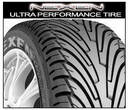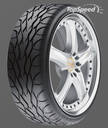In the early 1980’s Goodyear Tire prepared a few high performance tires for high performance cars, mostly the Chevrolet Corvette. The tire’s roots were based in formula one racing which demanded a tire that could withstand high speeds for an extended period and  deliver excellent traction at those speeds. The tire’s design was very different from most passenger car tires and was an overnight victory with devotees of the race car.
deliver excellent traction at those speeds. The tire’s design was very different from most passenger car tires and was an overnight victory with devotees of the race car.
The tire featured a low profile side wall, large tread blocks for good dry traction grip, a very stiff sidewall and a nylon cap over the steel belts to hold the tire together at high speeds. The tire received a unique sidewall rating and it was designated with a “V” which meant the tire had been safely tested in the laboratory to stay together at speeds as high as 149 mph. This is the first time the high performance tire was made in America and they were here to stay in America.
Cost of High Performance Tires
This tire was an instant hit and were also very costly, even by today’s  standards. It was not uncommon for them to cost over $200.00 each. This was an immense price for a tire considering the average tire cost around $45.00 at the time. Even today, high performance tires are much more expensive and consumers are still being hit with a surprise when it comes to replacing their tires.
standards. It was not uncommon for them to cost over $200.00 each. This was an immense price for a tire considering the average tire cost around $45.00 at the time. Even today, high performance tires are much more expensive and consumers are still being hit with a surprise when it comes to replacing their tires.
Since then however, the high performance tire has made its way onto almost every modern car. This is because automobile manufacturers found that high performance tires helped cars handle better. They corner better, stop better, steer better, were safer and worked well with anti-lock brake technology. These tires also appealed to the public’s imagination and romance. Many people wanted to have high performance tires. Because it made them feel a little better than the average driver who just drove his car on regular tires.
Touring Tires
During this time tire manufacturers began to produce a multitude of intermediate high performance tire known as “touring” tires which were  designed to accede to high performance demands and lessen ride and wear issues. Within a few years, there was an entire list of high performance tire categories. Which include Ultra-high performance, performance, touring, cosmetic performance, touring performance, etc.
designed to accede to high performance demands and lessen ride and wear issues. Within a few years, there was an entire list of high performance tire categories. Which include Ultra-high performance, performance, touring, cosmetic performance, touring performance, etc.
As technology advanced, automobile manufacturers began to equip nearly everything with a performance tire. Even the mini van because of one simple reason. They help sell cars because they are attractive. Also because of the benefits they add to the cars steering and braking.
The problem of this was that a consumer would buy a family sedan. Then end up unexpectedly having to pay up to $700 dollars for replacement tires. Performance tires in Canada are even more expensive with the same tires costing up to $300 more for a set of 4 tires. This creates problems because consumers don’t want to pay. Because they don’t believe they are “performance” drivers. So, instead of replacing them, they end up driving on bald tires.
But the fact is that we are all performance drivers. Everyone profits from performance tires. They are safer, stop better, react quicker, steer better and are less likely to blow out on the highway. They react and work better with modern car systems. It is a good idea to look into getting performance tires, if not for your flashy sports car, at least for your own safety.
For more sports car information, click here.